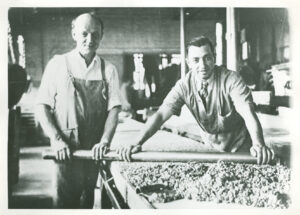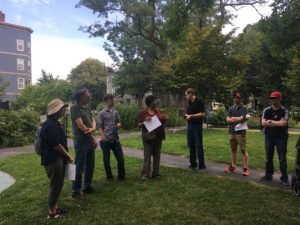
A new year, and History Cambridge puts focus onto a new neighborhood: North Cambridge
Above Image: A House in North Cambridge’s “Little France” is decorated for the Fourth of July, circa 1900. (Photo: History Cambridge)
By Beth Folsom
History Cambridge embarked on a model of programming in 2023 designed to focus on one of Cambridge’s 13 neighborhoods each year. Our first neighborhood, Cambridgeport, allowed us to explore in greater depth the history of the people, places and events that have made this area of the city the unique space it is today. Throughout this process, we have learned volumes about Cambridgeport through the conversations we have had with residents, and through our partnerships with individuals and organizations in the neighborhood – connections that will continue even as we move to our 2024 neighborhood, North Cambridge.
At the end of the last ice age – some 10,000 to 12,000 years ago – the area we now know as North Cambridge was under about a mile of ice. As the glaciers advanced, they ground the rock into sand and gravel and as they retreated, left behind hills – Observatory Hill, Strawberry Hill, Avon Hill; large accumulations of rock; and vast deposits of clay. The Alewife region was the Great Swamp. Garden Street was the Great Swamp Way. These marshes acted as a giant sponge for 7 square miles that included Cambridge, Arlington and Belmont. The Massachuset People and other local Indigenous groups used the marshes for fishing and foraging.
When the colonists descended, starting in 1630, they tried to farm this area but the marshland was high in salt content, which meant that the surrounding soil did not produce very well. When they found the clay, the colonists used it for small-scale building and pottery. Two hundred years later, in the mid-1840s, when the industrial revolution was in full swing, there was a huge demand in New England for nonflammable building material: The problem with wood construction is that coal fires tend to burn it down. New Englanders turned to brick to build their factories, mills, workers housing and buildings for the Harvard campus.
In 1858, around 187,000 bricks were produced each day in North Cambridge. That’s roughly 24 million bricks in one season! An average-size house (around 1,200 square feet) would require somewhere around 8,000 to 9,000 bricks. That means the bricks in North Cambridge could have been used to build more than two and a half thousand homes each year. Initially, a lot of small brick makers enjoyed success but, by World War I, most had been consolidated into the New England Brick Co., or Nebco for short.
Who worked in these clay pits and brickyards? Certainly there were workers from a wide range of racial and ethnic backgrounds but, as with many industries in Cambridge and beyond, the workforce tended to reflect the dominant immigrant groups of each period. In the 1840s and 1850s, the Irish immigrants arriving because of the potato famine made up the majority of the clay and brick industries. This was largely due to word-of-mouth referrals within the immigrant community – as new arrivals came to Cambridge seeking employment, they were often referred by friends or family members already working at the brickyards. Beginning in the 1870s, the Irish had started to gain a foothold in other local industries, and the new French Canadian arrivals began to fill the empty positions in brick making and pottery. This same pattern would repeat itself with Italians, Lithuanians, Poles and Black Americans, who were migrating out of the South and the West during the Great Migration of the early 20th century.
Over the past century, North Cambridge has seen much of its large-scale industrial production taper off, but its churches, schools and small businesses have allowed the neighborhood to retain its sense of community and character. Changing demographics and development have affected the area in positive and negative ways, but residents’ sense of neighborhood identity remains strong.
History Cambridge looks forward not only to sharing what we know about this neighborhood, but also to learning what residents know about their own local history and what questions they have about their neighborhood. In 2024, we will be creating programming that will document and share our own knowledge and what we learn in partnership with the North Cambridge community. Learn more about North Cambridge at our History Hub and sign up for our newsletter to keep up with all of our upcoming events and programs. We look forward to continuing to make history with you in 2024!
Beth Folsom is programs manager for History Cambridge.
This article was originally published in our “Did You Know?” column in Cambridge Day.






